skip to main |
skip to sidebar
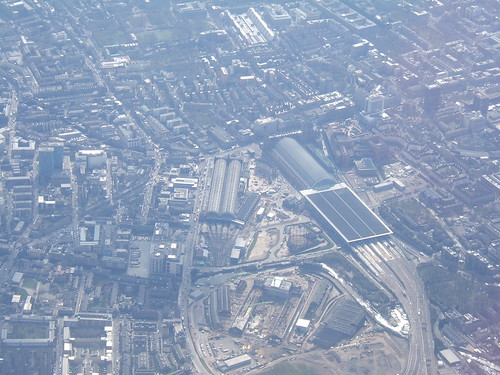
Aerial view taken in 2009 showing the twin train sheds of King's Cross (centre) and Barlow's train shed at St. Pancras International the with modern flat-roofed northern extension (right).
King's Cross station in London was opened in 1852 as the southern terminus of the Great Northern Railway. Twin trainsheds by Lewis Cubitt covered just two platforms (one arrival, one departure) separated by a number of sidings for storing passenger carriages. Growth in traffic resulted in a number of additional platforms being constructed within the twin trainshed. In 1875 a separate suburban station was added on the west side (now platforms 9,10 and 11) and, in 1878, underground connections allowed local trains from the north to pass directly onto the Metropolitan Railway. In 1923, King's Cross became part of the London and North Eastern Railway (LNER), becoming famous for the 'crack' East Coast Main Line expresses including the 'Flying Scotsman' service. In 1948, nationalisation of railways in Britain ushered in a more chequered period.
My first brief visit was when I was nine. I was most impressed by the hustle and bustle of a large terminus and by the Gresley 'Pacifics'. Over the years since, I've passed through or visited King's Cross station many times.
In 1974, my firm received an order for electrification telephone equipment for the Great Northern Electrification Project, covering 100 route-kilometres from King's Cross to Hitchin, via both the main line and the Hertford Loop, with an Electrical Control Room at Hornsey, about four miles north of King's Cross, London. For this project, we supplied telephones with mounting plates plus repeaters, terminal racks and a Cord Switchboard. We also took responsibility for installation and commissioning, including the lineside telephones. Handling all aspects of installation gave a new dimension to this project. That project is briefly mentioned in the post Electrification Telephone Systems for British Rail but I'll add more when I can.
In 2006, my firm started work on equipment for renewal of the Tunnel Telephone system on the Northern City Line from Moorgate to Finsbury Park (controlled from King's Cross Power Signal Box). The Northern City Line (and our equipment) is described in the post Northern City Line.
A visit to King's Cross in February 2008 in connection with that renewal work resulted in the post London's Terminal Stations which discussed King's Cross, St. Pancras and Euston. During that visit, I'd admired the old footbridge at King's Cross, halfway along the trainsheds, with its dual clockfaces.

King's Cross: View of station footbridge showing one clockface from platform level. In the background, the horizontal drive shaft linking both clockfaces back to the mechanism in the office building can be seen.
Sadly, on my return in October 2009, I'm afraid the footbridge was being demolished as part of a major redevelopment at King's Cross. There's a post about the redevelopment here.

King's Cross: View of station footbridge being demolished.
Despite electrification, two of the four long-distance trains pictured below in 2009 remained diesel-powered!

King's Cross Station in 2009.
At the end of 2009, I ran a couple of technical training courses at King's Cross covering maintenance of our Tunnel Telephone system. The first of these was in the famous East Side Offices.

King's Cross Station East side offices viewed from York Way in 2009.

The rather grand stairs halfway along the East Side Offices building.

Imagine the generations of Railway Officers who have worn away the carved newel cap.
The second training course was held within King's Cross Power Signal Box. Since the training room had a panoramic view of King's Cross station throat and the track remodelling in progress, I had some difficulty keeping my attention on the business in hand.

King's Cross station throat, viewed from the Power Signal Box.
Part of the remodelling involved an additional platform on the East Side, actually underneath the East Side offices. In the post about the redevelopment mentioned above, I reported that I'd been assured that the extra platform would not be '0' for technical reasons, but when I visited on 15th September 2010 I found that King's Cross now shared the rare distinction of possessing a Platform 0 (rendering my earlier post Platform Numbering Revisited out-of-date).
 King's Cross Station: Platform 0 looking north.
King's Cross Station: Platform 0 looking north.
Whilst on the topic of unusual platform numbers, in 2008 I'd been surprised to discover that, to satisfy Harry Potter fans, there was an opportunity to take a photograph of a luggage trolley disappearing through the wall leading to Platform 9-3/4!

A contractor takes a picture of a visitor at the entrance to platform 9-3/4 on 26-Feb-2008.
Returning in 2009 I was even more surprised to discover that the entrance had magically moved.

A visitor at the entrance to platform 9-3/4 on 21-Oct-2009 - location magically moved!
In June 2013, I first examined the now-completed redevelopment. In general, I approve of the treatment of the original buildings, although I'm not a fan of John McAslan's soaring concourse area (particularly when the supporting steel work is bathed in a rather lurid purple light).

King's Cross Station: The New Concourse illuminated in 2017.
But I applaud the restoration of the original appearance of Lewis Cubitt's 1852 train shed.

King's Cross Station: The simple but elegant end of the train shed is once-again revealed.
Related posts on other websites
London King's Cross railway station (Wikipedia)
Related posts on this website
Electrification Telephone Systems for British Rail (mentions Great Northern Suburban Electrification).
London's Terminal Stations (discusses King's Cross).
Northern City Line.
Redevelopment at King's Cross Station.
Class 373 Test Train to Grantham.
Rail Research UK Association Annual Conference 2017.
My Pictures
Where necessary, clicking on an image above will display an 'uncropped' view or, alternately, pictures from may be selected, viewed or downloaded, in various sizes, from the album listed:-
London: King's Cross Station.
 Comair 737 ZS-OKC on the ground at O. R. Tambo International Airport.
Comair 737 ZS-OKC on the ground at O. R. Tambo International Airport.
On my Safari Trip in February 2012 (described here, Boeing 737 ZS-OKC operated by Comair took me from O. R. Tambo to Livingstone. Whilst waiting to board, I noticed, marked in red on the side of the fuselage, the 'RVSM Sensitive Area'. I didn't know what 'RVSM' meant but it was not until I returned to the U.K. that I had an opportunity to research its significance (and it was almost another seven years before I wrote about it).
Although more modern techniques now exist, the basic method for determining an aircraft's altitude is by measuring barometric pressure with a 'pressure altimeter'. Increasing air traffic led to the introduction of a world-wide system of 'airways' with flying altitudes assigned to each aircraft to ensure safe vertical separation. Errors in measurement on the aircraft obviously potentially erode this separation. Continued growth in air traffic has led to improvements in pressure altimeters justifying an initial vertical separation of 2,000 feet between aircraft flying above Flight Level 290 ('Two,Nine,Zero') being reduced to 1,000 feet (as was already applied up to Flight Level 290). Of course, this requires suitably-tested equipment and the 'RVSM Sensitive Area' is kept pristine so that the air pressure sensed by the 'Pitot Tubes' feeding the pressure altimeter is not affected by turbulence.
Wikipedia has an article about this at Reduced vertical separation minima
.
The diagram below illustrating Non-RVSM and RVSM Flight Levels is from CSSI Inc:-

Non-RVSM and RVSM Flight Levels between FL290 and FL410.
CSSI Inc. also produced this sketch illustrating the effect of different errors on the altitude indicated to the pilot:-

Difference between Assigned and Actual Altitude.
There's more about altimeter setting on the excellent 'Skybrary' site here.
Of course, RVSM is just one feature of the amazing and complex Air Traffic Control system that world trade is dependent on.
Back in 2008, the post Work in progress stated my ambition regarding the backlog of draft blog posts to "Get 'em published, ready or not". How well did that work out? To my amazement, I have made 1,406 published posts at present, varying in length from the short to the quite long ("too long" do I hear you say?). But there are also 173 draft posts 'in the works', incomplete or awaiting further research.
The fact that I'm still working limits time available to write for the blog. I confess to still being a railway enthusiast (I think I prefer that term to 'railwayac' which I believe was used some time ago but unfortunately rhymes with 'maniac'). So that pastime consumes more of my available time (and is responsible for around half of the published posts). Finally, although my mobility is deteriorating with increasing age, my interest in travel is undiminished and any journey (even a modest one using the dreadful British railway system) supplies sufficient material for more unfinished posts.
The earlier 'Work in progress' post asked for the reader's indulgence regarding typographical and grammatical errors. Has that situation improved? Probably not. The editing software in 'Blogger' (which I still use) helpfully flags up spelling errors with a wiggly red underlining but, since it doesn't understand 'formatting directives', the editing screen is usually covered with highlighted formatting text, tending to hide the real errors. The other problem is that, just because a word is spelled correctly, it doesn't mean that's the word you intended. So, I will plod on, as best I can.
In the post An Apology, which appeared in 2009, I wrote about the perils of spelling place names, before digressing about L.M.S. signal box nameboards. For balance, below is a picture of a Great Western signal box nameboard. As I commented in the post here:-
The Great Western liked to dignify their signal boxes with a single, cast-iron name plate showing the name in full so I noticed the imposing length of the sign mounted on side facing the tracks reading 'SUTTON BRIDGE JUNCTION SIGNAL BOX'.

Shrewsbury area rail: Sutton Bridge Junction signal box, 28th July 2018.

Jan 'Blogging', 27th January 2019.
During the first of two visits I made to to Myanmar in 2017, on Sunday 7th May 2017, I travelled by train from Kalaw to Shwe Nyaung, as briefly described in the post here. More technical comments are in this present post.
The published timings of the train were:-
13:30 depart Kalaw
15:40 depart Heho
17:00 arrive Shwenyaung
This is train 141 booked to leave Thazi at 7.00 a.m. (Which I'd caught in 2016 when travelling from Thazi to Kalay as described in posts Thazi-Kalaw and Thazi - Kalaw (part 2)).
There was a particular reason I'd chosen to to now make the journey beyond Kalaw to Shwe Nyaung - I'd found out there was a circular loop or spiral, descending in our direction of travel between Heho and Shwe Nyaung. I might have been tempted to catch an ascending train, when the loco would be working hard but travelling on a descending train fitted in better with my overall programme and certainly emphasised the importance of brakes!
Kalaw Station (mileage: 369)
Division 4 of Myanma Railways
Kalaw is the headquarters of Division 4 of Myanma Railways and the Divisional offices face the station across the tracks.
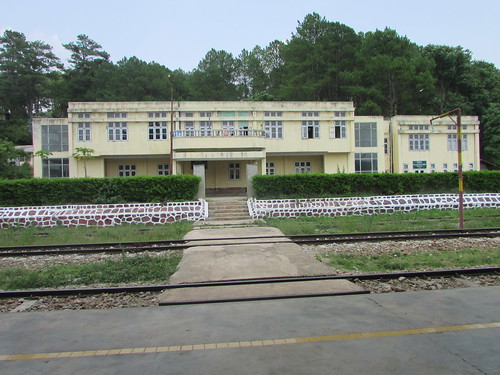 Kalaw Division Railway Offices stand opposite Kalaw Station.
Kalaw Division Railway Offices stand opposite Kalaw Station.
Map showing extent of Division 4
Click on map for larger view
Layout of Station
I'd first visited Kalaw Station (elevation 4297 feet) in 2016 when I'd arrived at Kalaw by train but I'd also studied the station the following day when travelling around Kalaw by road. In 2017, I first visited the station by road on our arrival on Saturday because my guide, Thandar Oo, wanted to confirm the train timings. So my pictures in the album Kalaw Station consolidates the pictures taken on these various visits. On the Sunday of our train journey to Shwe Nyaung, we arrived at the station nice and early so that I could take more pictures which form the start of the album Kalaw - Shwe Naung by train.
The station is provided with one broad platform situated on the left looking towards Shwe Naung.

Kalaw Station showing the covered waiting area on the broad platform.
There is a main line, passing loop, goods loop and three sidings with stop blocks. Points are controlled from single lever point frames with Trapped Key Interlocking arrangements supervised by the Station Master. Points are equipped with the usual semi-derelict point indicators.
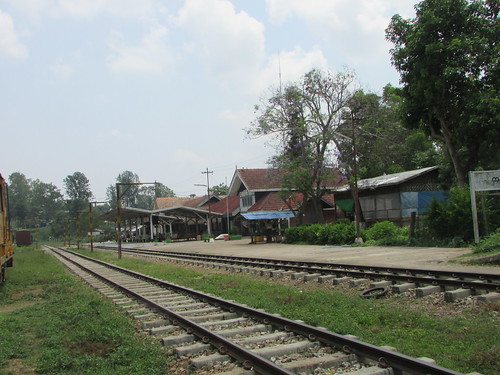
General view of Kalaw Station looking towards Thazi.
An Outer Home signal approaching the station is provided in each direction and both are controlled from a Signal Capstan on the station platform. I'd previously seen these Signal Capstans (which I sometimes called 'windlasses') on the line to Maymyo.

Outer Home Signal Capstan at Kalaw (Up/Down)
The Outer Home signals are preceded by fixed Distant signals. There is a level crossing with manual gates on the Thazi side of the station. Movements over the level crossing and through points are authorised by a green hand signal from the pointsman/crossing keeper.
The usual diagram in the Station Master's office makes the arrangements clearer:-

Track diagram in Station Master's office at Kalaw. Shwe Naung is to the left, Thazi to the right.
Click here for larger view
Kalaw: Arrival and Departure of my train
A member of the station staff (whom I'll call the 'pointsman') was despatched to to the Signal Capstan to make sure that the Outer Home was 'clear' for the approaching train, then he carried on to the loop points to check that they were correctly set and 'clipped' (secured with a point clip, similar to a 'G'-clamp, and padlocked), ready to give a 'green' handsignal to the approaching train to authorise the train's entry to the platform. Since there's also a level crossing next to the points, a Crossing Keeper also appeared to push the two hand operated gates across the road after which he also displayed a 'green' handsignal. The 2,000 horse power diesel-electric locomotive and its train slowly bounced over the pointwork and crawled into the platform.

Kalaw - Shwe Naung by train: DF.2010 arriving from Thazi. Pointsman on left, Crossing Keeper on right, both displaying green flags.
Another member of station staff stood ready on the platform to collect a document pouch offered by the Second Man on the locomotive. I assume the pouch surrendered the 'Line Clear' form which had authorised departure from the previous Block Station.

Kalaw - Shwe Naung by train: My train arriving at Kalaw late at 14:57.
I'd not seen a document pouch in use previously. A cane 'hoop' is more common, as shown below.

Myo Haung Signal Cabin, Mandalay: A railwayman displays the cane hoop with the vital Paper Line Clear Form attached. This form is issued by the Controller and, when received by the driver, authorises the train movement.
The train comprised four bogie coaches and two bogie goods vans, one with 'duckets' (a part-glazed lookout used by the guard). There was the usual flurry of activity as passengers boarded and alighted and freight was loaded and unloaded. After a plaintive sounding of the locomotive air horn, we quietly departed.
Track maintenance gang
Not long after leaving Kalaw, we slowed right down passing a Permanent Way gang, apparently carrying out spot replacement of rotten wooden sleepers with reinforced concrete ones.

Track Repairs.
The line to Aung Ban
The line twisted and turned over the undulating route across the mountains meaning that our locomotive was working quite hard at times.

Kalaw - Shwe Naung by train.
Aung Ban Station (mileage: 376)
Our first stop was at Aung Ban (elevation 4219 feet, just 78 feet lower than Kalaw Station). As at Kalaw, approaching the station in each direction there is a fixed Distant signal. The design of these varies quite a bit from site to site.

Kalaw - Shwe Naung by train: Aung Ban semaphore fixed distant.
The distant is followed by an Outer Home signal the design of which can vary. Both upper-quadrant and lower quadrant arrangements are in use.

Kalaw - Shwe Naung by train: Aung Ban upper-quadrant semaphore stop signal.
I'd visited Aung Ban by road four days previously, on my way from Heho Airport to Loikaw. In addition to the main line and passing loop, there are four siding loops, plus the diverging branch line to Loikaw. At the Kalaw end of the station, there's a large water tank on a steel truss support to feed a derelict water column, with a swan-neck cast delivery pipe.

Aung Ban Station: Derelict water column and steel water tower.
Track 4 stabled a coach and an old bogie goods van probably used by railway workers as they were next to Railway Gang Car ED/RGC113 used for track maintenance.

Kalaw - Shwe Naung by train: Railway Gang Car ED/RGC113 at Aung Ban.
After a brief stop, we set off again.
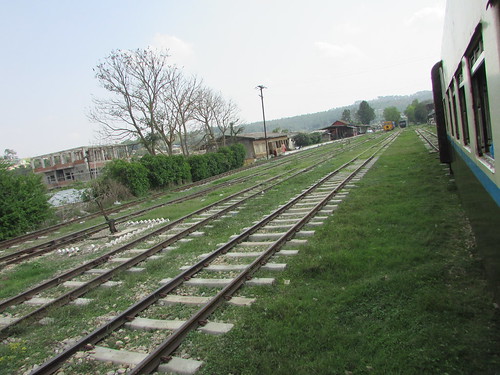
Kalaw - Shwe Naung by train: Leaving Aung Ban, showing sidings on the left and single platform on the right. Note the single lever point frame.
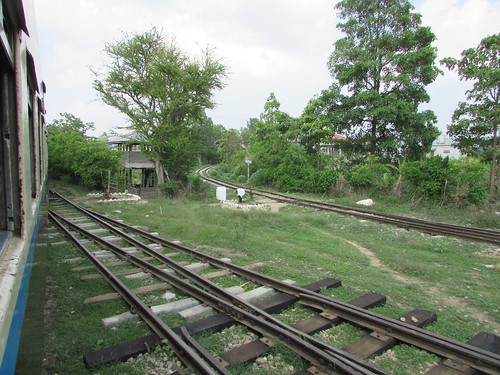
Kalaw - Shwe Naung by train: Leaving Aung Ban, showing branch to Loikaw diverging, two single lever point frames and a point indicator. Note raised hut.
Once again, we were in countryside, sometimes twisting and turning around hills, sometimes overlooking grazing herds and, at least once, passing over a watercourse on a steel girder bridge set on tall stone piers before reaching Kan Na.
Kan Na Station (mileage: 384.75)
We stopped briefly at the rural station of Kan Na. I was surprised to see a lower-quadrant semaphore 'stop' signal beyond the platform, obstinately at 'danger', even as we drew up to the signal. Presently, a pointsman cleared the signal (arm pointing downwards, as you'd expect a lower quadrant to do) and we departed. The signal was protecting a facing point leading to a short siding with a stop block, so I concluded at the time that we were about to descend a reasonably severe gradient but, lacking a gradient diagram, I can't be certain..

Kalaw - Shwe Naung by train: Passing Kan Na semaphore fixed distant.

Kalaw - Shwe Naung by train: Kan Na station.

Kalaw - Shwe Naung by train: Kan Na station showing semaphore stop signal with Trapped Key locking box, point indicator, hand point lever and separate warning sign.
As we continued towards Heho, the scenery was initially quite rugged but then turned into a high plain, with extensive vegetable-growing and villagers tending the crop.
Heho Station (mileage: 404)
We passed Heho Airport on our left and then the fixed semaphore distant for Heho. The Outer Home signal was 'off' and I managed a reasonable picture. A square concrete foundation has two short steel projections to which the signal post is bolted. The post is formed of two parallel channel-sections of different lengths held parallel by bolting-through nicely-cast spacer blocks. Near the base of the signal, a large pulley wheel diverts the signal operating wire vertically up the post. Near the top of the shorter channel section, a lever is pivoted so that the pull of the signal wire on one end of the lever is converted into a push on the solid rod which extends upwards to operate the signal arm. I was amused to note that three weights had been wired to the end of the lever to ensure that the signal arm returns to danger when the signal wire slackens. The arm itself is pivoted near the top of the longer channel-section which is terminated in a neat, cast finial. On this particular example, the signal arm appeared quite elderly - corrugated steel bolted to a cast spectacle and apparently of the pattern used by The Railway Signal Co, where an arm that looks as if designed to be lower-quadrant is arranged as upper-quadrant. The back-blinder was in the correct position (had the signal been illuminated) and spectacle glasses were still intact (both 'clear' but I couldn't determine whether glass, plastic or metal gauze). Variations of this pattern are found all over Myanmar and, as here, they often lack an access ladder. At Heho, this signal is controlled from a signal capstan on the station platform.

Kalaw - Shwe Naung by train: Semaphore stop signal, Heho.
And so we arrived at Heho where I took plenty of pictures whilst the various vendors plied their wares. Two days later, I made a second visit by road, met the station master and took more pictures (in the album Heho Station). Heho has the main line, passing loop, and one siding loops with moveable scotches (a second siding loop has been abandoned). Points, equipped with point indicators, are controlled from single lever point frames with Trapped Key Interlocking arrangements supervised by the Station Master.

Kalaw - Shwe Naung by train: Entering Heho, showing single lever point frame and abandoned water column.
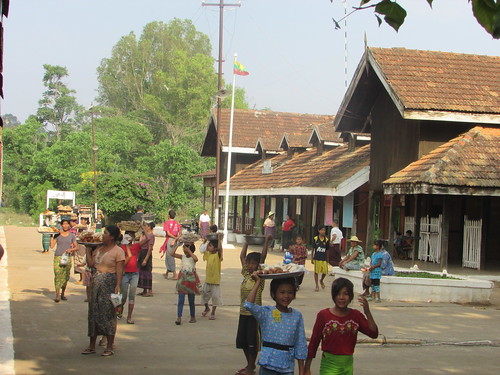
Kalaw - Shwe Naung by train: Heho.

Kalaw - Shwe Naung by train: Heho Station. Signal Capstan for Up Outer Signal.
During my second visit to Heho station, I was able to photograph the track diagram in the Station Master's Office.

Track diagram in Station Master's Office, Heho. Kalaw is to the left, Shwe Naung to the right.
Click here for larger version.
Unlike, for instance, Kalaw the signal capstan on the platform at Heho only operates the Outer Home Signal for trains heading towards Shwe Nyaung because the Outer Signal heading towards Kalay protects a set of 'trap' points. So, in this case, the signal is operated using a nearby single lever signal frame with Trapped Key locking box shown in the picture below. Again, I assume that this is because the gradient is falling towards Heho but I haven't confirmed this. This signal is similar in design to the other Heho Outer signal illustrated above but, in this case, the 'modern' signal arm has no spectacle, is arranged as an upper-quadrant and is provided with a signal ladder.

Kalaw - Shwe Naung by train: Leaving Heho, showing semaphore stop signal, single lever signal frame with Trapped Key locking box and Hand point lever for 'trap' points. Note the bullock cart on the roadway.
The Spiral at Ba Wa Sam Sa Ra Bridge
After a lot more twisting and turning to pick our way through the contours of this mountainous area, we came to the Spiral. To lose height rapidly, the railway takes a descending single spiral and crosses under the high level line at the Ba Wa Sam Sa Ra Bridge. After passing a fixed distant, I was not surprised that we came to a 'stop' signal at danger with another fixed distant mounted under the 'stop' arm. This was the last chance for the driver to satisfy himself that the train brakes were operating correctly. Then the signal came 'off' and we gingerly moved forwards.
This was a most curious signal with a short post of channel section painted alternately black and white, rather than white (not that unusual) but with three short lengths of 'rebar' welded to the post, one above the other, to form a ladder. The stop signal arm was corrugated steel, probably old and attached to a spectacle which, from its proportions, was also old. Like the two signals I'd spotted at Kan Na, it was built to be lower-quadrant but, when the handsignalman had 'cleared' the signal, the arm was 'up', not 'down'. As we passed the signal, I looked in vain for any operating mechanism and reluctantly decided the handsignalman had climbed up the 'rebar' to somehow alter the signal aspect. Incidentally, the painted 'vee' on the front of the distant signal arm mounted on the same post was white, not black as usually found in Myanmar although the 'vee' on the rear of the arm was the expected black.

Kalaw - Shwe Naung by train: Semaphore stop signal and fixed distant signal, Ba Wa Sam Sa Ra Bridge.
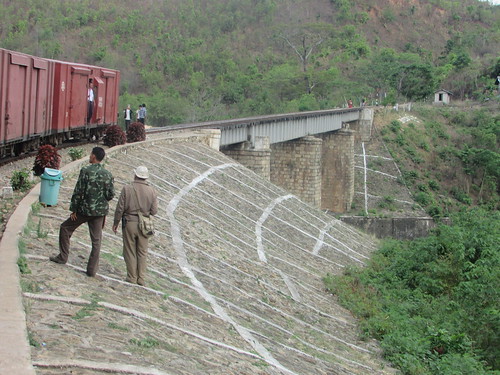
Kalaw - Shwe Naung by train: View looking back, immediately after passing over the Ba Wa Sam Sa Ra Bridge at high level.
With plenty of braking to control our speed, the train then descended the spiral and passed under the bridge we'd crossed over around three minutes earlier.

Kalaw - Shwe Naung by train: View looking ahead, immediately before passing under the Ba Wa Sam Sa Ra Bridge at low level.
I was quite impressed by our descent of the spiral.
Shwe Nyaung Station (mileage: 369)
It took us around half an hour to travel from the Spiral to Shwe Nyaung station but, by that time, I was getting fairly tired and didn't pay too much attention, I'm afraid.
Shwer Nyaung has the main line, passing loop, and a couple of siding loops. Points, some equipped with point indicators, are controlled from single lever point frames with Trapped Key Interlocking arrangements supervised by the Station Master.

Kalaw - Shwe Naung by train: Arriving at Shwe Naung, with two Single lever point frames, one with point indicator.

Kalaw - Shwe Naung by train: Arriving at Shwe Naung: L-R: Siding, siding, loop, platform line.

Shwe Naung Station:
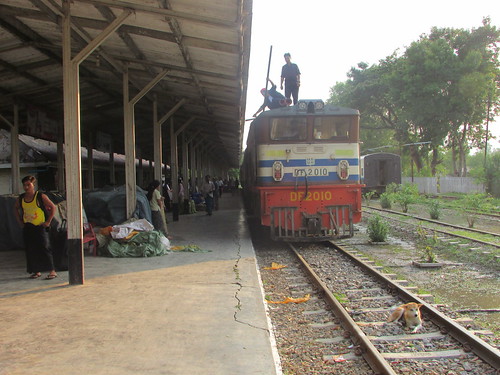
Shwe Naung Station: DF.2010 on arrival. Second man and mechanic on loco roof performing checks (fuel?). Note dog between the rails.
History
History of rail transport in Myanmar (Wikipedia).
Related posts in my blog
On to Inle Lake.
All my Myanma Railways posts.
My Pictures
Pictures in this article can be viewed uncropped by clicking on the image. To view in other resolutions or download, select from the albums below:-
Kalaw - Shwe Naung by train.
Kalaw Station (2016, 2017).
Aung Ban Station.
Heho Station.
All my Myanma Railways Pictures.








 King's Cross Station: Platform 0 looking north.
King's Cross Station: Platform 0 looking north.










































